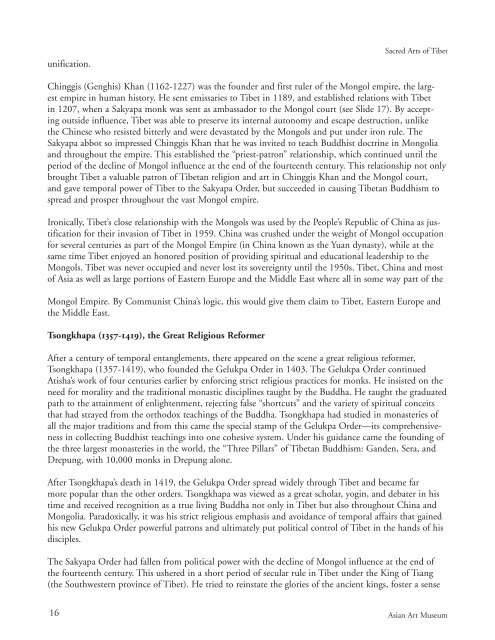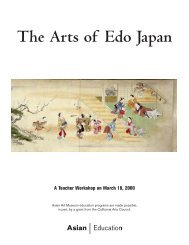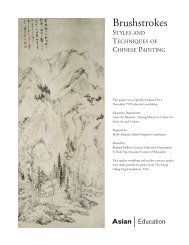Sacred Arts of Tibet (.pdf) - Asian Art Museum | Education
Sacred Arts of Tibet (.pdf) - Asian Art Museum | Education
Sacred Arts of Tibet (.pdf) - Asian Art Museum | Education
Create successful ePaper yourself
Turn your PDF publications into a flip-book with our unique Google optimized e-Paper software.
unification.<br />
<strong>Sacred</strong> <strong><strong>Art</strong>s</strong> <strong>of</strong> <strong>Tibet</strong><br />
Chinggis (Genghis) Khan (1162-1227) was the founder and first ruler <strong>of</strong> the Mongol empire, the largest<br />
empire in human history. He sent emissaries to <strong>Tibet</strong> in 1189, and established relations with <strong>Tibet</strong><br />
in 1207, when a Sakyapa monk was sent as ambassador to the Mongol court (see Slide 17). By accepting<br />
outside influence, <strong>Tibet</strong> was able to preserve its internal autonomy and escape destruction, unlike<br />
the Chinese who resisted bitterly and were devastated by the Mongols and put under iron rule. The<br />
Sakyapa abbot so impressed Chinggis Khan that he was invited to teach Buddhist doctrine in Mongolia<br />
and throughout the empire. This established the “priest-patron” relationship, which continued until the<br />
period <strong>of</strong> the decline <strong>of</strong> Mongol influence at the end <strong>of</strong> the fourteenth century. This relationship not only<br />
brought <strong>Tibet</strong> a valuable patron <strong>of</strong> <strong>Tibet</strong>an religion and art in Chinggis Khan and the Mongol court,<br />
and gave temporal power <strong>of</strong> <strong>Tibet</strong> to the Sakyapa Order, but succeeded in causing <strong>Tibet</strong>an Buddhism to<br />
spread and prosper throughout the vast Mongol empire.<br />
Ironically, <strong>Tibet</strong>’s close relationship with the Mongols was used by the People’s Republic <strong>of</strong> China as justification<br />
for their invasion <strong>of</strong> <strong>Tibet</strong> in 1959. China was crushed under the weight <strong>of</strong> Mongol occupation<br />
for several centuries as part <strong>of</strong> the Mongol Empire (in China known as the Yuan dynasty), while at the<br />
same time <strong>Tibet</strong> enjoyed an honored position <strong>of</strong> providing spiritual and educational leadership to the<br />
Mongols. <strong>Tibet</strong> was never occupied and never lost its sovereignty until the 1950s. <strong>Tibet</strong>, China and most<br />
<strong>of</strong> Asia as well as large portions <strong>of</strong> Eastern Europe and the Middle East where all in some way part <strong>of</strong> the<br />
Mongol Empire. By Communist China’s logic, this would give them claim to <strong>Tibet</strong>, Eastern Europe and<br />
the Middle East.<br />
Tsongkhapa (1357-1419), the Great Religious Reformer<br />
After a century <strong>of</strong> temporal entanglements, there appeared on the scene a great religious reformer,<br />
Tsongkhapa (1357-1419), who founded the Gelukpa Order in 1403. The Gelukpa Order continued<br />
Atisha’s work <strong>of</strong> four centuries earlier by enforcing strict religious practices for monks. He insisted on the<br />
need for morality and the traditional monastic disciplines taught by the Buddha. He taught the graduated<br />
path to the attainment <strong>of</strong> enlightenment, rejecting false “shortcuts” and the variety <strong>of</strong> spiritual conceits<br />
that had strayed from the orthodox teachings <strong>of</strong> the Buddha. Tsongkhapa had studied in monasteries <strong>of</strong><br />
all the major traditions and from this came the special stamp <strong>of</strong> the Gelukpa Order—its comprehensiveness<br />
in collecting Buddhist teachings into one cohesive system. Under his guidance came the founding <strong>of</strong><br />
the three largest monasteries in the world, the “Three Pillars” <strong>of</strong> <strong>Tibet</strong>an Buddhism: Ganden, Sera, and<br />
Drepung, with 10,000 monks in Drepung alone.<br />
After Tsongkhapa’s death in 1419, the Gelukpa Order spread widely through <strong>Tibet</strong> and became far<br />
more popular than the other orders. Tsongkhapa was viewed as a great scholar, yogin, and debater in his<br />
time and received recognition as a true living Buddha not only in <strong>Tibet</strong> but also throughout China and<br />
Mongolia. Paradoxically, it was his strict religious emphasis and avoidance <strong>of</strong> temporal affairs that gained<br />
his new Gelukpa Order powerful patrons and ultimately put political control <strong>of</strong> <strong>Tibet</strong> in the hands <strong>of</strong> his<br />
disciples.<br />
The Sakyapa Order had fallen from political power with the decline <strong>of</strong> Mongol influence at the end <strong>of</strong><br />
the fourteenth century. This ushered in a short period <strong>of</strong> secular rule in <strong>Tibet</strong> under the King <strong>of</strong> Tsang<br />
(the Southwestern province <strong>of</strong> <strong>Tibet</strong>). He tried to reinstate the glories <strong>of</strong> the ancient kings, foster a sense<br />
16<br />
<strong>Asian</strong> <strong>Art</strong> <strong>Museum</strong>
















